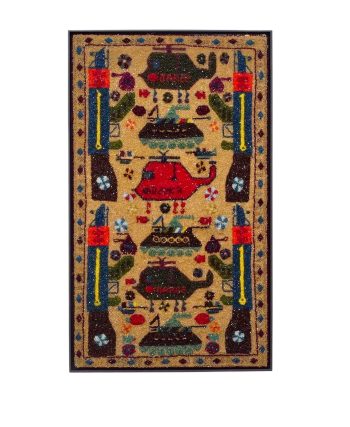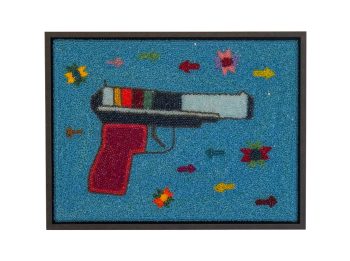Sissi Farassat
The artist Sissi Farassat was born in Iran, Afghanistan’s neighboring country. In this Persian part of the Middle East, carpets have been woven for thousands of years, and Farassat herself began sewing and knotting at a very young age. Today, she lives in Vienna and embellishes photographic prints with Swarovski crystals. One of her most compelling series deals with the so-called Afghan war rugs, either in the form of her own photographic reproductions or as self-portraits in front of one of these carpets, which she then painstakingly embellishes with crystals over the course of weeks. She uses the image of the war rug as a starting point, a kind of template or stencil, which she fills with sparkling, multicolored gemstones—at once highlighting and obscuring the underlying image.
The resulting work, with its dazzling and materially heightened effect, becomes something that curator Elnaz Bokharachi calls “a typical example of Iranian visual art” that “visually protests.” Bokharachi further writes that Farassat’s works “reveal historical traumas while masking the horrors of war; instead, they emphasize the ornamental aesthetics of her cultural heritage and the Iranian tradition of carpet weaving.” In other words, the artist fuses content and form in an inseparable way: repetition and concealment, emphasis and denial, tradition and present, gesture and image.
Moreover, in this work, Sissi Farassat subtly suggests the reality of Afghan women who remain invisible behind their spectacular craftsmanship and who are forced to passively—and massively—endure the impacts of military and paramilitary conflicts.
Farassat contrasts these intense and violence-laden images with photographs of clouds and the sky, which she embellishes in the same way with Swarovski crystals. These small, almost intimate works gain a double charge in the context of the war rugs. The clouds radiate peace and hope; and yet, this blue-and-white sky also remains a threatening sphere of drones and fighter jets—of military surveillance and bombing. Sissi Farassat succeeds in bringing us closer to the omnipresent horror from war-torn regions like Afghanistan through these small windows, deliberately employing both an explicit and open visual language.
It is precisely in the interplay of violence and tranquility where the brutality of modern warfare lies: the deadly bomb that strikes seemingly “out of the blue” into a deceptively normal everyday life. (Daniel Blochwitz)
Participated Exhibitions


